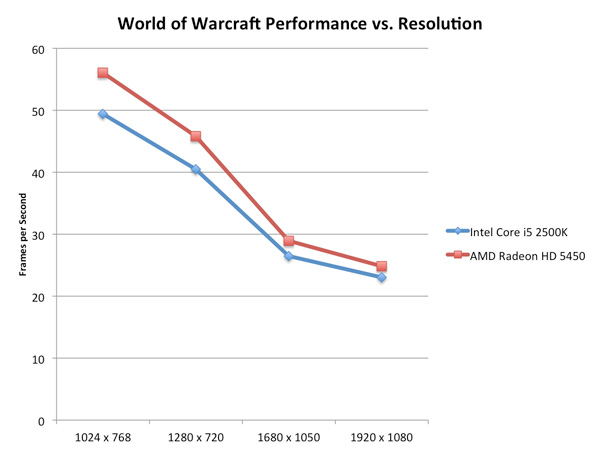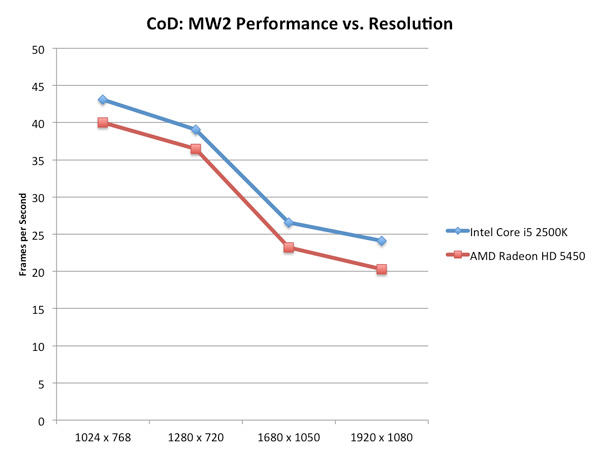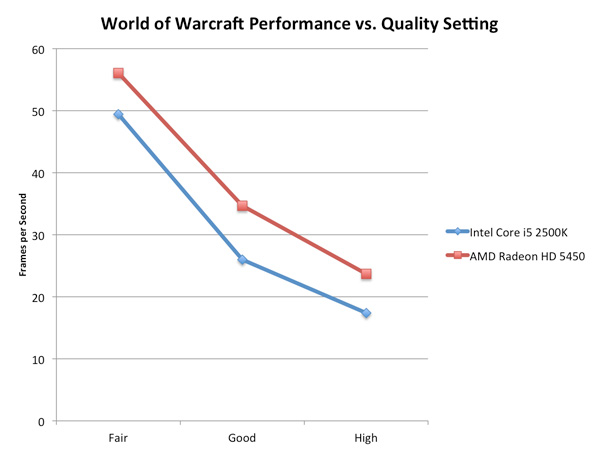The Sandy Bridge Review: Intel Core i7-2600K, i5-2500K and Core i3-2100 Tested
by Anand Lal Shimpi on January 3, 2011 12:01 AM ESTResolution Scaling with Intel HD Graphics 3000
All of our tests on the previous page were done at 1024x768, but how much of a hit do you really get when you push higher resolutions? Does the gap widen between a discrete GPU and Intel's HD Graphics as you increase resolution?
On the contrary: low-end GPUs run into memory bandwidth limitations just as quickly (if not quicker) than Intel's integrated graphics. Spend about $70 and you'll see a wider gap, but if you pit Intel's HD Graphics 3000 against a Radeon HD 5450 the two actually get closer in performance the higher the resolution is—at least in memory bandwidth bound scenarios:

Call of Duty: Modern Warfare 2 stresses compute a bit more at higher resolutions and thus the performance gap widens rather than closes:

For the most part, at low quality settings, Intel's HD Graphics 3000 scales with resolution similarly to a low-end discrete GPU.
Graphics Quality Scaling
The biggest issue with integrated and any sort of low-end graphics is that you have to run games at absurdly low quality settings to avoid dropping below smooth frame rates. The impact of going to higher quality settings is much greater on Intel's HD Graphics 3000 than on a discrete card as you can see by the chart below.

The performance gap between the two is actually its widest at WoW's "Good" quality settings. Moving beyond that however shrinks the gap a bit as the Radeon HD 5450 runs into memory bandwidth/compute bottlenecks of its own.










283 Comments
View All Comments
RMSe17 - Monday, January 3, 2011 - link
Time for an upgrade :)marc1000 - Monday, January 3, 2011 - link
I decided to jump the first core-i lineup, and sitck to an old core2duo for some more time... now seems the wait was worth it!I just hope the prices outside US/Europe will be reasonable..
thanks Anand,
vol7ron - Monday, January 3, 2011 - link
I think there are many of us that had the same idea. Unless needing to upgrade due to malfunction or new laptop purchase, holding C2D til past the i-Series was the best move to make; whereas buying into C2D asap was the best move at the time.Still going to wait for prices to fall and more USB3 adoption. Expected new purchase: mid-2011-mid 2012
vol7ron - Monday, January 3, 2011 - link
by "i-Series" it should have said "1st gen. i-Series"CptTripps - Tuesday, January 4, 2011 - link
Ya know I usually do as you are but was an early adopter of the i7 920. Looking now it seems I made the right choice. I have had 2 years of kickassery and my processor still holds up rather well in this article.hogey74 - Thursday, January 6, 2011 - link
Me too! I've got an e8400 running at 3.9 with almost zero OC know-how and its done me well. I might snap up an i7 if they and their mobos get cheap when sandy bridge has been out a few months... but may well skip that generation all together.Einy0 - Monday, January 3, 2011 - link
Holy crapola AMD really needs Bulldozer now. Even in heavily threaded video encoding the 2600K at $300 is blowing the 1100T x6 out of the water. This is the the Core 2 Duo vs. A64 X2 all over again. Will Bulldozer be another Phenom, a day late and a dollar short? TLB bug anyone? As a PC enthusiast I really want to see competition to keep prices in check. If I had to upgrade today, I can't see how I could turn down the 2600K...medi01 - Monday, January 3, 2011 - link
Did you add mobo price into equation?I don't get all the excitement, really. If anything, Intel's anti-overclocking moves
MonkeyPaw - Monday, January 3, 2011 - link
Yeah, new Intel motherboard models are never cheap. I don't understand why the price remains so high when more an more functionality is moving to the CPU. The other killer is that you need a new board for every Intel CPU update.Lastly, it's hard to throw the "buy now" tag on it with AMD's new architecture over the horizon. Sure, AMD has a tough act to follow, but it's still an unknown that I think is worth waiting for (if it's a dog, you can still buy Intel). Keep in mind that Bulldozer will have a pretty strong IGP, one that may make decent IGP gaming a reality. It will become a matter of how powerful the x86 portion of the Bulldozer is, and they are trying a considerably different approach. Considering the amount of money you'll be paying, you might as well see how AMD shakes out. I guess it just depends on if what you have today can get you by just a little longer.
dertechie - Monday, January 3, 2011 - link
You're conflating Bulldozer and Llano there. Bulldozer is the new architecture, coming to the desktop as an 8-core throughput monster. Llano is the first desktop APU, cramming 4 32nm K10.5 cores and a Redwood class GPU onto the die. The next generation of desktop APUs will be using Bulldozer cores.